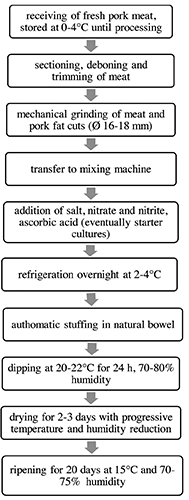Occurrence and traceability of Salmonella spp. in five Sardinian fermented sausage facilities
- PMID: 31008088
- PMCID: PMC6452083
- DOI: 10.4081/ijfs.2019.8011
Occurrence and traceability of Salmonella spp. in five Sardinian fermented sausage facilities
Abstract
The aims of the present study were to evaluate the presence of Salmonella in five fermented sausage processing plants and their products during the production process, and to trace the possible sources of contamination. A total of 270 samples were collected: mixture of ground pork meat and fat, products at the end of acidification, sausages at the end of ripening and, during production stages, surfaces in contact with meat and surfaces not in contact with meat. For samples of ground meat, product at the end of acidification and sausages at the end of ripening, the pH and water activity (aw), were determined. All the samples were tested for the presence of Salmonella. Thirtytwo Salmonella isolates were obtained, subjected to serotyping and PFGE. The sausages at the end of ripening pH and aw mean values were 5.39±0.24 and 0.91±0.03, respectively. Salmonella was detected in three processing plants with an overall prevalence of 16.7% in food samples and 5.8% in environmental samples. Salmonella prevalence was 24% in ground meat and products at the end of acidification and was also detected in a sample of sausage at the end of ripening (2%). In environmental samples, Salmonella was detected in 6.6% of surfaces in contact with meat and 5% of surfaces not in contact with meat. Five serotypes were identified among 32 isolates: S. Derby (37.5%), S. Typhimurium and S. Rissen (both 25%), S. Give and monophasic S. Typhimurium (both 6.25%). Six different pulsotypes were obtained with PFGE. The serotypes and the PFGE pattern of the strains were specific for each facility with no overlapping between different processing plants. The same observation can be pointed out considering different sampling days for the same processing plants, thus presumably indicating the raw material (ground pork meat and fat) as the source of contamination. The detection of Salmonella in a sample of sausage at the end of ripening highlights the ability of the pathogen to survive during manufacturing process.
Keywords: Salmonella; meat products; pork; pulsotype.
Conflict of interest statement
Conflict of interests: the authors declare no potential conflict of interests.
Figures
References
-
- Andreoli G, Merla C, Valle CD, Corpus F, Morganti M, D’incau M, Colmegna S, Marone P, Fabbi M, Barco L, Carra E, 2017. Foodborne salmonellosis in Italy: characterization of Salmonella enterica serovar Typhimurium and monophasic variant 4,[5],12:i-isolated from salami and human patients. J Food Protect 14:632-9. - PubMed
-
- Arguello H, Carvajal A, Naharro G, Arcos M, Rodicio MR, Martin MC, Rubio P, 2013. Sero and genotyping of Salmonella in slaughter pigs, from farm to cutting plant, with a focus on the slaughter process. Int J Food Microbiol 161:44-52. - PubMed
-
- Arnedo-Pena A, Sabater-Vidal S, Herrera- León S, Bellido-Blasco JB, Silvestre- Silvestre E, Meseguer-Ferrer N, Yague-Muñoz A, Gil-Fortuño M, Romeu-García A, Moreno-Muñoz R, 2016. An outbreak of monophasic and biphasic Salmonella Typhimurium, and Salmonella Derby associated with the consumption of dried pork sausage in Castellon (Spain). Enferm Infec Micr Cl 34:544-50. - PubMed
-
- Barbuti S, Parolari G, 2002. Validation of manufacturing process to control pathogenic bacteria in typical dry fermented product. Meat Sci 62:323-9. - PubMed
LinkOut - more resources
Full Text Sources
Miscellaneous

